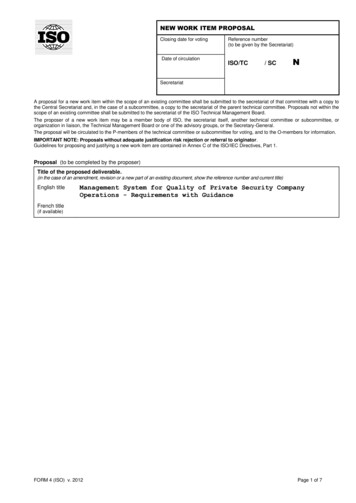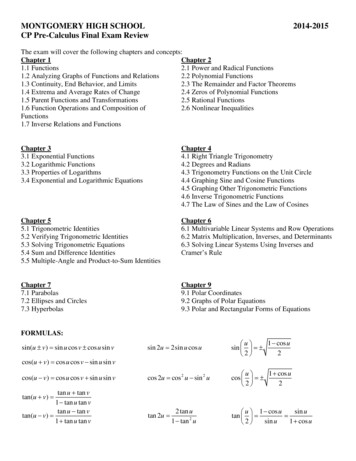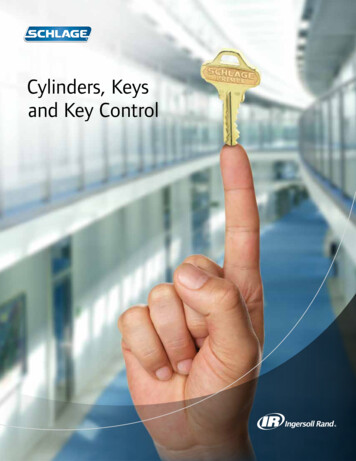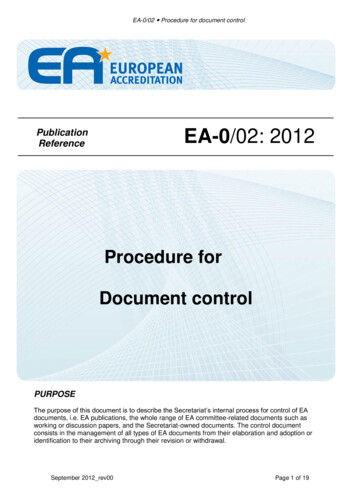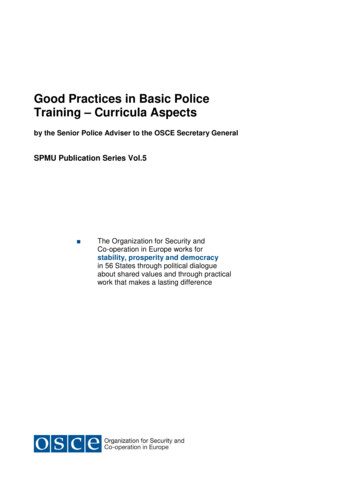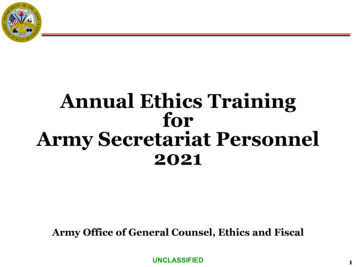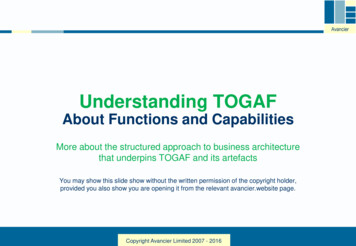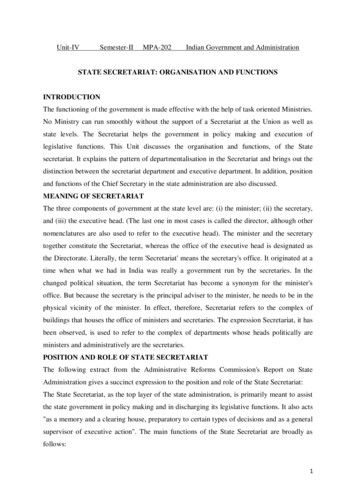
Transcription
Unit-IVSemester-IIMPA-202Indian Government and AdministrationSTATE SECRETARIAT: ORGANISATION AND FUNCTIONSINTRODUCTIONThe functioning of the government is made effective with the help of task oriented Ministries.No Ministry can run smoothly without the support of a Secretariat at the Union as well asstate levels. The Secretariat helps the government in policy making and execution oflegislative functions. This Unit discusses the organisation and functions, of the Statesecretariat. It explains the pattern of departmentalisation in the Secretariat and brings out thedistinction between the secretariat department and executive department. In addition, positionand functions of the Chief Secretary in the state administration are also discussed.MEANING OF SECRETARIATThe three components of government at the state level are: (i) the minister; (ii) the secretary,and (iii) the executive head. (The last one in most cases is called the director, although othernomenclatures are also used to refer to the executive head). The minister and the secretarytogether constitute the Secretariat, whereas the office of the executive head is designated asthe Directorate. Literally, the term 'Secretariat' means the secretary's office. It originated at atime when what we had in India was really a government run by the secretaries. In thechanged political situation, the term Secretariat has become a synonym for the minister'soffice. But because the secretary is the principal adviser to the minister, he needs to be in thephysical vicinity of the minister. In effect, therefore, Secretariat refers to the complex ofbuildings that houses the office of ministers and secretaries. The expression Secretariat, it hasbeen observed, is used to refer to the complex of departments whose heads politically areministers and administratively are the secretaries.POSITION AND ROLE OF STATE SECRETARIATThe following extract from the Administrative Reforms Commission's Report on StateAdministration gives a succinct expression to the position and role of the State Secretariat:The State Secretariat, as the top layer of the state administration, is primarily meant to assistthe state government in policy making and in discharging its legislative functions. It also acts"as a memory and a clearing house, preparatory to certain types of decisions and as a generalsupervisor of executive action". The main functions of the State Secretariat are broadly asfollows:1
1. Assisting the ministers in policy making, in modifying policies from time to time andin discharging their legislative responsibilities.2. Framing draft legislation, and rules and regulations.3. Coordinating policies and programmes, supervising and controlling their execution,and reviewing of the results.4. Budgeting and control of expenditure.5. Maintaining contact with the Government of India and other state governments; and6. Overseeing the smooth and efficient running of the administrative machinery andinitiating measures to develop greater personnel and organisational competence.The administrative philosophy to which the secretariat system owes its existence is thatpolicy making must be kept separate from policy execution. Several advantages are claimedin favour of such an arrangement:i.Freedom from operational involvement makes the policy making apparatusforward looking and allows it to think in terms of overall goals of governmentrather than narrow, sectional interests of individual departments.ii.Policy making receives the time and attention it deserves, if different set ofpersons are charged with the functions of policy making as well as its execution.This is because, policy making, is a serious exercise in drawing up what would bea future course of action. It should not be treated as less urgent than policyexecution, which involves routine, day-to-day administration.iii.Secretariat serves as a disinterested adviser to the minister. It is important toremember that the secretary is the secretary to the government and not to theminister concerned, which ensures objective examination of the proposals comingfrom the executive departments. It enables a more balanced scrutiny of proposals.iv.Policy making must be separated from current administration and day-to-dayimplementation should be left to a different agency with executive freedom, whichensures delegation of authority.It should be in order at this stage to portray the broad dimensions of the Secretariat's role insome detail. The foremost of these is the Secretariat's role in policy making. It assists theministers in the formulation of governmental policies.This has many aspects. First, the secretary supplies to the minister all the data andinformation needed for policy formulation. Second, the secretaries sometimes provide theprogrammes, with content by working out their details, on whose strength ministers are votedto power. Third, the Secretariat assists ministers in their legislative work. Drafts of2
legislations to be introduced in the legislature by ministers are prepared by the secretaries.Besides, to answer questions in the Legislature, the minister needs relevant information; thesecretary supplies this information to the minister. Secretary also collects informationrequired with respect to the legislative committees.Fourth, the Secretariat functions as an institutionalised memory. This means that theemerging problems require an examination in the light of precedents. Records and filesmaintained in the Secretariat serve as an institutional memory and ensure continuity andconsistency in the disposal of cases. Fifth, the Secretariat is a channel of communicationbetween one government and another, and between the government and such agencies as thePlanning Commission and Finance Commission. Finally, the Secretariat evaluates and keepstrack of execution of policies by the field agencies.STRUCTURE OF A TYPICAL SECRETARIAT DEPARTMENTVertically, a typical Secretariat Department has two hierarchical formations; that of theofficers and, what is described as the office.OfficersConventionally, the officers' hierarchy has had three levels. Under this, a typicaladministrative department is headed by a secretary who will have a complement of deputysecretaries and under assistant secretaries. But with growth in the functions of varioussecretariat departments, the number of levels in the officers' hierarchy has been on theincrease. As a result, between the secretary and the deputy secretary, in some states, positionsof additional /or joint secretaries have also been created.OfficeA unique feature of the Secretariat System in India has been the distinction between its twocomponent parts - "the transitory cadre of a few superior officers" and "the permanentoffice". The officers in each department, because they hold tenure posts, come and go. It isthe office, which is manned by permanent functionaries, which provides the much neededelement of continuity to the secretariat department. Unlike officers, the office constitutes thepermanent element in the secretariat system. The office component is comprised ofsuperintendents (or section officers), assistants, upper and lower division clerks, steno-typistsand typists. Office performs the spadework on the basis of which the officers consider casesand make decisions. Office supplies officers with materials, which constitute the basis fordecision-making.The structure of a typical department comprises:3
Department–SecretaryWing–Additional Joint SecretaryDivision–Deputy Secretary/DirectorBranch–Under SecretarySection–Section OfficerThe section is the lowest organisational unit and it is under the charge of a section officer.Other functionaries in a section are assistants, upper and lower division clerks, steno-typists,typists, etc. A section is referred to as the office. Two sections constitute the branch, which isunder the charge of an under-secretary.Two branches ordinarily form a division, which is headed by a deputy secretary. When thevolume of work of a department is more than a secretary can manage, one or more wings areestablished with a joint secretary in charge of each wing. At the top of the organisationalhierarchy is the secretary who is in charge of the department.PATTERN OF DEPARTMENTALISATION IN STATE SECRETARIATEach secretary is normally in charge of more than one department. The number of secretariatdepartments would therefore be larger than the number of secretaries. The number ofsecretariat departments, quite naturally, varies from state to state. Their number broadlyranges between 10 and 40 in different states. The number of departments in a particular stateis not necessarily related to its size in terms of population. For instance, a small state likeMizoram had as many as secretariat departments in 1987, the corresponding figure forAndhra Pradesh (which is a much larger state), was 19 in 1982. Following is a typicalexample of the pattern of departmentalisation at the Secretariat Level:General Administration Department Home Department Revenue Department Food and Agriculture Department Finance and Planning Department (Planning Wing) Finance and Planning Department (Finance Wing) Law Department Irrigation and Power Department Medical and Health Department Education Department4
Industries Department Legislature Department Panchayati Raj Department Command Area Development Department Transport, Roads and Buildings Department Housing and Municipal Administration and Urban Development Department Labour, Employment and Technical Education Department Social Welfare Department Rural Development Department Forest Department Environment Department Women and Child Welfare DepartmentLarger number of departments, in particular states, would result from restricting the scope ofthe functions and charges of those which may be created. Partly, such - increase in thenumber of departments may arise from the peculiar problems a particular state may face.There is a lot of criticism about the work allocation existing in the secretariat departments,which is: First, work allocation is lop-sided in that some departments are burdened with morework than others. Second, allocation is far from rational even in terms of homogeneity ofwork. Not only are the subjects handled by a particular department too numerous andtherefore unmanageable but these are also too heterogeneous, causing problems ofcoordination. These are further aggravated when charges of particular departments areincomplete in scope.DISTINCTION BETWEEN SECRETARIAT-DEPARTMENT AND EXECUTIVEDEPARTMENT: DISCRETE PROCESSES OR A CONTINUUMThe Secretariat Department must be distinguished from the executive department. TheSecretariat has the function of aiding, assisting and advising the political executive in arrivingat policy choices. The heads of executive departments – who are in the main known asdirector (although other nomenclatures are also used to refer to them) - have theresponsibility of implementing policies formulated by the political executive. Therefore, thesecretaries assist in policy formulation whereas the directors' role lies in executing policy.Long ago, the Simon Commission had observed, that executive department is anadministrative unit separate from the Secretariat, which reaches its apex, usually, in a singleofficer like the Inspector General of Police, or the Chief Conservator of Forests, outside the5
Secretariat altogether. Such a head of a department will usually be concerned principally witha single secretary to Government and a single minister of his orders and the funds which hehas to spend.Each secretariat department is in charge of a number of executive departments. This numbervaries over a wide range with some departments taking charge of a much larger number ofexecutive heads than others. There is an average of 6 to 7 executive departments in relation toone secretariat department. However, it must be carefully noted that not all secretariatdepartments have executive departments attached to the. Some of the secretariat departmentsare engaged in advisory and controlling functions and therefore do not have executivedepartments reporting to them. Examples are Departments of Law, Finance, etc.The Secretariat and executive departments organisationally express the policy formulationand policy execution processes involved in the functioning of the government; the two maybe looked upon as extensions of the personality of the Council of Ministers. The former is apolicy-making organ, the latter a policy executing organ.The secretariat department is normally headed by a generalist civil servant (drawn from theIAS), the executive department by a specialist. The specialist (the head of the executivedepartment) functions under the supervision of the generalist (the secretary or the head of thesecretariat department). This can be illustrated with some examples, Director of Agriculture,who is a specialist, in that he is trained in and holds a formal degree in agricultural sciences,would function under the supervision of the Secretary, Agriculture (a generalist, an IAS). Thelatter represents agriculture department at the secretariat level, whereas the Director ofAgriculture represents agriculture department at the executive level. The director is theexecutive head of the agriculture department - the Directorate of Agriculture. Likewise, thehome department in the Secretariat has the Director-general of Police as its executive head ofthe department. . Similar correlation obtains between education secretary and educationdirector, industries secretary and industries director, social welfare secretary and socialwelfare director, and so on.We have emphasised the distinctness of the roles of the Secretariat and the Directorate bysaying that, while the former is concerned with policy formulation, the latter is concernedwith policy execution (or with administering policy or to put it yet more simply, theadministration). The question which may, therefore, be asked is whether policy andadministration are discrete processes. The answer is that at a conceptual level, the two aredistinct; it is possible to identify and define them as two clearly distinguishable phenomena.But at a practical plane, the two are inextricably interlinked, even tend to become6
indistinguishable and, therefore, it is difficult to say where the policy ends and administrationbegins.Policy is concerned with political choices and involves questions of broader values, whereasadministration is concerned with implementing programmes emanating from particular policydecisions. Administration, therefore, involves such details of execution as framingorganisational structures, staffing of organisations, coordinating activities, directing,controlling, and motivating the personnel and so on.That the two are dichotomous is the traditional view, which owes its origin to WoodrowWilson's essay of 1887, 'The Study of Administration'. Politics, he said, is the proper activityof Legislature and other policy-making groups (e.g., political parties, cabinet, etc.).Administration is the sphere of administrators who carry out the policies stated in the laws.The context of the dichotomy was the civil service reform movement of the 1880s in theUnited States, which aimed to eliminate political interference in civil service. It was arguedthat civil service recruitment should, in the interest of administrative efficiency, be based onconsiderations of merit and fitness rather than partisan politics. In other words, politicsshould be kept out of administration. Max Weber further justified separation of policy fromadministration by arguing that the attributes of politicians are exactly the opposite of those ofthe civil servants. The essence of politics is to take a stand, to take personal responsibility forthe policies decided on, and to admit the transitory nature of the political role. The essence ofadministration is to execute conscientiously the order of the political authority, even if itappears wrong to the administrator. The administrator is politically neutral. He simply doeswhat he is asked to do and assumes no personal responsibility.However, the complexities of governmental operations have increasingly requiredadministrators to become involved in policy making or political decisions. As a result of this,it is in practice found to be difficult to draw a clear boundary separating policy andadministration, or to say where policy ends and administration begins. This would be clearfrom the following:Sources of Administrative ExpertiseThere are several sources from which the modem day administrators have obtained a kind ofexpertise, which the politicians need to use when formulating policies as:(i)The administrators stay in office longer they are career civil servants) than thepoliticians, who come and go with elections, the former have opportunities ofgiving sustained attention to problems. From this, they gain an invaluable kind ofpractical knowledge that comes from the experience of handling these very7
problems day in and day out. This knowledge is conserved in records andtransmitted to new generations of civil servants through training programmes.This monopoly of experience and practical knowledge coupled with continuity inoffice gives them a decisive edge over politicians in framing policies.(ii)(ii) The administrators are in possession of facts, figures, information andintelligence regarding the specific areas in which policies are to be framed.Politicians would need these data and statistics in formulating policies.(iii)Administrative expertise also comes pre-eminently from the fact that thegovernments of today employ a large variety of professionals (doctors, engineers,scientists, economists, etc.). The) possess technical knowledge, which forms avital, input in policy making.(iv)The advent of merit system has also helped to build up administrative expertise byattracting better talent in civil service and loosening the grip of politicians on civilservice.Administrators' Role in Policy MakingThe increase in civil service expertise, together with growth in the functions of governmentand growing complexity of administration, has resulted in an increasing dependence ofpoliticians on administrators in the task of policy making. This is reflected in the following:i)Policy making exercise is done on the basis of facts, figures, information and data,which are supplied by the bureaucracy. In other words, politicians, in order toenhance the credibility of the policies they he, depend on the administrators' datasupport to their policies.ii)Civil servants based on their long administrative experience, tender advice to thelay politicians on the administrative, technical and financial feasibility of thevarious policy options under consideration.iii)Civil servants prepare the draft legislations (bills), which after ministerialapproval, are placed before the legislature for its consideration. In other words,administrators initiate the process of public policy formulation, which in its finalform assumes the shape of an Act passed by the Legislature.iv)Administrators formulate' policy through the exercise of administrative discretion.When an administrator is required to choose between alternative courses of actionwithin a policy frame, he is said to exercise discretion. In this sense,administrators are described supplementary lawmakers. Because here, the actualcontent of policy becomes entirely a matter for bureaucratic determination. Here8
administrators actually decide how the power of the State shall be used in specificcases. In modern times, there has come about a tremendous increase inadministrative discretion by virtue of an incessant increase in the volume oflegislation to be enacted. Legislature is under the circumstances, compelled toconfine itself to indicating broad framework of law, leaving details to be filled upby the administrative agencies.The growing variety and complexity of laws to be enacted has further circumscribed theLegislature's competence. The legislators do not have the technical know-how and training toventure into the details of particular legislations. This further necessitates exercise ofadministrative discretion. And, at any rate, if the Legislature delves into the details of eachlaw, this would be at the cost of other important duties and functions of the legislators andtherefore an undesirable thing to happen. This, coupled with the assurance that it has thenecessary means available to hold administration accountable to itself has, in fact,encouraged the Legislature in its attitude of not delving too deeply into the details of theenactments it formulates. And, it is not possible to work out the details of the enactments foranother reason too. Ultimately, the policy is to be executed in the field where anadministrator must necessarily face a bewildering variety of situations as he sets himself tothe task of policy execution. For the law making agency, it is clearly not possible to visualise,at the point of legislation, the different variety of situations that may arise in the field. Forthis reason, once again, the policy makers must do no more than provide only broadguidelines in the legislations they frame.9
Unit-IV Semester-II MPA-202 Indian Government and Administration STATE SECRETARIAT: ORGANISATION AND FUNCTIONS INTRODUCTION The functioning of the government is made effective with the help of task oriented Ministries. No Ministry can run smoothly without the support of a Secretariat at the Union as well as state levels.
